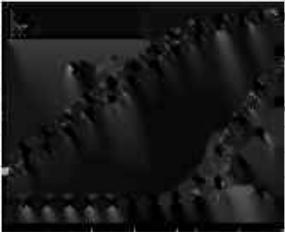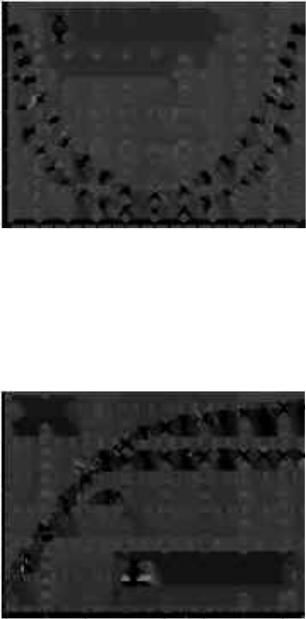
Книги+1 / 2013 [Chandan_Kumar_Sarkar]_Technology_CAD
.pdfDevice Simulation Using Silvaco ATLAS Tool |
223 |
method fermi compress
diffuse time=5 temp=900 weto press=0.8 implant arsenic dose=1.0e15 energy=30 pearson
Step 14: Implant p-doped halo (NMOS).
implant boron dose=3.0e13 energy=15 tilt=30 fullrotat
Step 15: Form an oxide spacer to provide a barrier of isolation and to aide in patterning for the next implantation.
depo oxide thick=0.10 divisions=8 etch oxide dry thick=0.10
Step 16: Form the heavy drain/source region by implantation with arsenic instead of phosphorus as in the case of the light drain/source.
implant arsenic dose=5e15 energy=60 pearson
Step 17: Perform annealing in the presence of nitrogen to diffuse the drain/source created.
method fermi compress
diffuse time=1 temp=1000 nitro press=1.0
Step 18: Etch the oxide layer above the drain/source region to pattern the source/drain contact metal.
etch oxide left p1.x=0.35
Step 19: Deposit aluminum to create electrodes with a low ohmic contact.
deposit alumin thick=0.03 divi=2
Step 20: Etch away unwanted materials.
etch alumin right p1.x=0.33
Step 21: Mirror the structure to obtain the full symmetrical device.
structure mirror right
Step 22: Define the electrodes and save the obtained structure.
electrode name=gate x=0.59 y=0.1 electrode name=source x=0.2
224 |
Technology Computer Aided Design: Simulation for VLSI MOSFET |
electrode name=drain x=1.0 electrode name=substrate backside save outfile=nmos_bulk.str
Step 23: Extract different MOSFET parameters and plot the structure.
# to extract gate oxide thickness
extract name=“gateox” thickness oxide mat.occno=1 x.val=0.59
# extract final S/D junction depth Xj
extract name=“nxj” xj silicon mat.occno=1 x.val=0.2 junc. occno=1
# extract the N++ regions sheet resistance...
extract name=“n++ sheet rho” sheet.res material=“Silicon” mat. occno=1 x.val=0.2 region.occno=1
#extract the sheet rho under the spacer, of the LDD region...
extract name=“ldd sheet rho” sheet.res material=“Silicon” mat. occno=1 x.val=0.49 region.occno=1
#extract the surface conc under the channel....
extract name=“chan surf conc” surf.conc impurity=“Net Doping” material=“Silicon” mat.occno=1 x.val=0.6
# potting the structure tonyplot nmos_bulk.str
The program to extract different parameters, threshold voltage, and Ids-Vgs characterization using the structure generated with ATHENA code is described above. The threshold voltage is extracted by finding the intersection of the maximum slope of the Ids-Vgs curve with the x-axis. The output of the extract command will appear in the lower DECKBUILD window after running the code.
go atlas
#IMPORT THE structure to use the auto-interface between ATHENA and ATLAS
mesh inf=nmos_bulk.str
#model definition
models cvt srh numcarr=2
# method specifiatiion
method newton itlimit=25 trap atrap=0.5 maxtrap=4 autonr nrcriterion=0.1 tol.time=0.005 dt.min=1e-25
#solve for id-vgs by ramping gate voltage and store the answer in the log file

Device Simulation Using Silvaco ATLAS Tool |
225 |
|
solve init |
|
|
solve |
vdrain=0.1 |
|
log outf=bulkHalo.log master |
|
|
solve |
name=gate vgate=0.1 vfinal=1.5 vstep=0.1 |
|
#plot the log file tonyplot bulkHalo.log
#extraction of threshold voltage
extract name=“vt” (xintercept(maxslope(curve(abs(v.”gate”),abs (i.”drain”)))) - abs(ave(v.”drain”))/2.0)
quit
5.13.2 Simulation Results
Figure 5.12 shows the Ids-Vgs characteristics of an n-channel MOSFET simulated using program 5.13.1 for two different devices. One of them is a pocketed device that considers the halo implantation process step, and the other is a non-pocketed device that omits the halo implantation process step. A process called pocket implant or halo implant is introduced in which the locally high doping concentration in the channel near the source/drain junctions is created. The technology has been given prominence to tailor the shortchannel performances of diminuend devices. Therefore, it is widely used to reduce threshold voltage roll-off and punch-through [41–46].
Drain Current Ids in [A] Shown in Log Scale
0.00008
With halo implant
Without halo implant
1E–6
0.00006
1E–9
0.00004
1E–12
0.00002
1E–15
0.00000
1E–18
0.2 |
0.4 |
0.6 |
0.8 |
1.0 |
1.2 |
1.4 |
|
Gate-to-source Voltage Vgs in [V] |
|
|
|||
Drain Current Ids in [A] Shown in Linear Scale
FIGURE 5.12
Simulation data of the drain–current Ids versus the gate–source voltage Vgs for devices with and without halo implantation.

226 |
Technology Computer Aided Design: Simulation for VLSI MOSFET |
A highly doped halo surrounding either the source or drain proves to be effective in increasing switching speed by more than a factor of two over the conventional MOSFET [47]. It reduces leakage current and, hence, reduces static power dissipation [48]. However, careful tuning of pocket implant parameters in order to obtain desired electrical performance of nanoMOSFETs is always necessary. Variations of pocket implant energy, implant dosage, and tilt angle influence the characteristics of nano-n-MOSFETs [49,51]. However, careful tradeoffs between minimum channel length and other device electrical parameters are required.
Figure 5.12 demonstrates an increase of the subthreshold current due to the drain-induced barrier lowering suffered by the non-pocketed device compared to the pocketed device. At low gate voltages, the additional potential barriers created by the pockets are strong enough for controlling the current, resulting in a comparative lower current for halo-doped MOSFETs in the subthreshold region.
5.14 Example 4: Volume Inversion Double-Gate (DG) MOSFET
As CMOS scaling is approaching its limits, DG MOSFET is becoming a very promising solution for the fabrication of high-performance devices for lowpower applications [35].
A DG MOSFET is considered electrostatically superior (channel is controlled by the gate voltage, not by the drain to source voltage) compared to single-gate MOSFET due to its strong coupling between the conduction channel and gate electrodes.
The use of symmetric DG MOSFET allows the suppressing of short-chan- nel effects like drain-induced barrier lowering (DIBL) and subthreshold slope degradation, making unnecessary the conventional use of high channel doping densities and gradients compared to a bulk MOSFET [52,53]. Here symmetric means that the same voltage bias is applied to the two gates having the same work function. The use of an undoped body [54,55] also results in enhanced mobility by reducing charged-impurity scattering and in reduced device parameter variation by eliminating the statistical fluctuation of dopant concentration [56–58]. Therefore, doping of the DG MOSFET is not desired and is usually not used, but there is always a small unintentional doping density ~1015 cm–3 during fabrication [59]. Therefore, a lightly doped DG MOSFET is considered in this simulation.
In this example, ATLAS is used to simulate 50 nm DG n-MOSFET having abrupt source/drain junctions (i.e., Leff = Lmet = 50 nm [60]). The device parameters are as follows: channel width W = 50 nm, channel length L = 50 nm, silicon thickness tSi = 20 nm, equivalent gate oxide thickness tox = 2 nm, doping concentration of the silicon channel NA = 1015 cm–3, doping concentration of
Device Simulation Using Silvaco ATLAS Tool |
227 |
the source/drain contact regions ND = 1020 cm–3, and mid-gap metal gate with workfunction 4.74 eV.
5.14.1 Program for Structure of DG MOSFET
# Program to generate the structure of DG MOSFET
go atlas
mesh space.mult=1.0
# mesh definition in x direction x.mesh loc=0.00 spac=0.01 x.mesh loc=0.05 spac=0.001 x.mesh loc=0.075 spac=0.005 x.mesh loc=0.1 spac=0.001
x.mesh loc=0.15 spac=0.01
#mesh definition in y direction y.mesh loc=-0.002 spac=0.001 y.mesh loc=0 spac=0.0004
y.mesh loc=0.01 spac=0.001 y.mesh loc=0.02 spac=0.0004 y.mesh loc=0.022 spac=0.001
#region definition
region num=1 y.min=0 y.max=0.02 silicon region num=2 y.min=-0.002 y.max=0 oxide region num=3 y.min=0.02 y.max=0.022 oxide
# electrode definition
electrode name=gate number=1 x.min=0.05 x.max=0.1 top electrode name=gate1 number=2 x.min=0.05 x.max=0.1 bottom electrode name=source number=3 left length=0.05 y.min=0 y.max=0
electrode name=drain number=4 right length=0.05 y.min=0 y.max=0
# doping specification
doping uniform conc=1e15 p.type region=1
doping uniform conc=1e20 n.type x.left=0 x.right=0.05 region=1 doping uniform conc=1e20 n.type x.left=0.1 x.right=0.15 region=1
# save and display the structure save outfile=dgmos.str
tonyplot dgmos.str quit
Quantum confinement effects will not be taken into account here, because silicon film thickness greater than 10 nm [61] and length greater than 10 nm
228 |
Technology Computer Aided Design: Simulation for VLSI MOSFET |
are being considered. Quantum mechanical tunneling from source to drain (through the barrier) degrades device performance for extreme short length devices, but for channel lengths longer than about 10 nm, MOSFETs behave classically [62].
The surface potential ΨS is the most natural variable for the formulation of MOS device physics. It is defined as the difference between the electrostatic potential at the SiO2/Si interface and the potential in the neutral bulk region due to band bending. Recently there has been wide consensus in the compact modeling community that traditional threshold-voltage-based models have reached the limit of their usefulness and need to be replaced with more advanced models based on surface potential referred to as surface-potential- based models, because an accurate physical description of MOSFET can be easily obtained by the use of surface-potential-based models.
5.14.2 Program to Obtain Potential Variation of DG MOSFET
# Program for obtaining variation of surface and body center potential
go atlas
#IMPORT THE MESH structure mesh inf=dgmos.str
#contact specification
contact name=gate n.poly workfunction=4.74
#two separate electrodes gate and gate1 are shorted by “common” parameter
contact name=gate1 n.poly workfunction=4.74 common=gate contact name=source neutral
contact name=drain neutral
#model declaration
models auger srh conmob fldmob bgn temperature=300
# method definition
method newton itlimit=25 trap
# solution for specific gate and drain bias solve init
solve vdrain=0.0 solve vgate=0.0
#saving the structure file save outf=dg.str
#extraction of surface potential where y.val=0.0 (semiconductor front gate oxide interface) along the depth and saving the curve in a file

Device Simulation Using Silvaco ATLAS Tool |
229 |
extract name=“srp_profile1” curve(depth, potential material=“Silicon” mat.occno=1 y.val=0.0) outfile=“extract1. dat”
#extraction of channel center potential where y.val=0.01(center of the SOI silicon semiconductor body
y=tSi/2) along the depth and saving the curve in a file extract name=“srp_profile2” curve(depth, potential material=“Silicon” mat.occno=1 y.val=0.01) outfile=“extract2. dat”
#plot the files in the same window overlaid
tonyplot -overlay extract1.dat extract2.dat quit
5.14.3 Simulation Results
Figure 5.14 shows the variation of surface and channel center potential of DG MOSFET shown in Figure 5.13 using the simulation of codes listed in Sections 5.14.1 and 5.14.2. Figure 5.14 portrays the potential with gate and drain bias equal to zero. However, it is possible to obtain potentials for various bias conditions by changing the gate and the drain bias in the program listed in Section 5.14.2, subjected to convergence of the solution attained.
Figure 5.15 presents the surface potential ΨS and potential at the center of the channel Ψ0, evaluated for gate voltage varying from 0 V to 1.5 V in steps of 0.1 V by changing the program for every step change. It is observed that below threshold, while the semiconductor charge is small, there is volume inversion, and the potential remains essentially flat (ΨS = Ψ0) throughout the
20 nm
Source |
Front gate |
Drain |
|
2 nm |
|
n+ |
50 nm |
n+ |
50 nm |
|
50 nm |
|
2 nm |
|
|
Back gate |
|
FIGURE 5.13
A fully depleted thin-film DG SOI MOSFET.

230 |
Technology Computer Aided Design: Simulation for VLSI MOSFET |
Surface Potential in [V]
0.6
Surface potential ΨS
0.5Channel center potential Ψ0
0.4 |
Vds = 0.0 V, Vgs = 0.0 V |
0.3
0.2
0.1
0.0
0 |
5 |
10 |
15 |
20 |
25 |
30 |
35 |
40 |
45 |
50 |
|
Distance along the Channel from Source to Drain in [nm] |
|
||||||||
FIGURE 5.14
Plot of surface potential and channel center potential versus position along the channel from source to drain for Vds = 0 V and Vgs = 0 V.
Potential in [V]
0.6 |
Vds = 0.0 V |
|
|
|
|
|
|
0.5 |
|
|
|
|
|
|
|
0.4 |
|
|
|
|
|
|
|
|
|
|
Crossover |
|
|
|
|
0.3 |
|
|
point |
|
|
|
|
0.2 |
|
|
|
|
|
|
|
0.1 |
|
|
|
Surface potential ΨS |
|
||
|
|
|
Channel center potential Ψ0 |
|
|||
|
|
|
|
|
|||
0.0 |
|
|
|
|
|
|
|
0.0 |
0.2 |
0.4 |
0.6 |
0.8 |
1.0 |
1.2 |
1.4 |
|
|
Gate-to-source Voltage Vgs in [V] |
|
|
|||
FIGURE 5.15
Variation of surface potential ΨS and channel center potential Ψ0 versus gate-to-source voltage Vgs with x = L/2 for a fixed channel length L = 50 nm and Vds = 0.0 V.
Device Simulation Using Silvaco ATLAS Tool |
231 |
entire silicon film thickness, with both ΨS and Ψ0 closely following the gate voltage. As the gate voltage increases toward threshold, the electron density becomes significant. As a result, ΨS continues to increase slowly, and Ψ0 starts to depart from ΨS and later saturates after being pinned to a maximum value. The mobile charge near the silicon surfaces screens the gate field from the center of the silicon film, and ΨS and Ψ0 become de-coupled (i.e., there is no volume inversion). The channel potential versus gate voltage characteristics for the devices having equal lengths but different thicknesses pass through a single common point termed the crossover point [63], which is also shown in Figure 5.15.
5.14.4 Program to Obtain Ids-Vgs Characteristics of DG MOSFET
# Program to obtain Id-Vgs characteristics
go atlas
#IMPORT THE MESH mesh inf=dgmos.str
#contact specification
contact name=gate n.poly workfunction=4.74
contact name=gate1 n.poly workfunction=4.74 common=gate contact name=source neutral
contact name=drain neutral
# model declaration
models auger srh conmob fldmob bgn temperature=300
# method definition
method newton itlimit=25 trap
# initial solution and drain bias specification solve init
solve vdrain=0.05 #solve vdrain=0.1 #solve vdrain=0.5 #solve vdrain=1.5
#output log file declaration log outf=dg1.log
#solution to obtain solution for id-vgs characteristics by ramping Vgs
solve name=gate vgate=0 vfinal=1.2 vstep=0.05
#plotting the structure
tonyplot dg1.log quit

232 |
Technology Computer Aided Design: Simulation for VLSI MOSFET |
Drain Current Ids in [A]
0.01 |
|
|
|
|
|
|
|
|
|
|
|
|
1E–3 |
|
|
|
|
|
|
|
|
|
|
|
|
1E–4 |
|
|
|
|
|
|
|
|
Vds = 1.5 V |
|
||
1E–5 |
|
|
|
|
|
|
|
|
Vds = 0.05 V |
|
||
|
|
|
|
|
|
|
|
|
|
|
|
|
1E–6 |
|
|
|
|
DIBL (mV/V) |
|
|
|
|
|
||
|
|
|
|
|
|
|
|
|
|
|||
1E–7 |
|
|
|
|
= (0.2866 – 0.1994)*103/(1.5 – 0.05) |
|
||||||
1E–8 |
|
|
|
|
= (63.58) |
|
|
|
|
|
|
|
|
|
|
|
|
|
|
|
|
|
|
|
|
1E–9 |
|
|
|
|
|
|
|
|
|
|
|
|
1E–10 |
|
|
|
SS = 72.6 mV/decade |
|
|
|
|
|
|||
1E–11 |
|
|
|
|
|
|
|
|
|
|
|
|
1E–12 |
|
|
|
|
|
|
|
|
|
|
|
|
0.0 |
0.1 |
0.2 |
0.3 |
0.4 |
0.5 |
0.6 |
0.7 |
0.8 |
0.9 |
1.0 |
1.1 |
1.2 |
Gate-to-source Voltage Vgs in [V]
FIGURE 5.16
Drain current as a function of gate-to-source voltage for two different values of Vds. Also shown is the calculation of DIBL and the subthreshold slope.
5.14.5 Simulation Results
Figure 5.16 shows the horizontally translated Ids-Vgs characteristics for low (Vds = 0.05 V) and high (Vds = 1.5 V). The translation is known as DIBL and is characterized by the number of millivolts of translation per volt of change in drain voltage. In this case the DIBL is equal to 63.58 mv/V, which is satisfactory because well-designed MOSFETs typically exhibit DIBL < 100 mV/V.
Figure 5.16 also indicates subthreshold swing (SS) characterized by the slope of the Ids-Vgs curve in the subthreshold region, which is the number of millivolts of increase in gate voltage needed to increase the drain current by a factor of 10. The theoretical lower limit of SS is 60 mV/decade at room temperature, while for well-designed MOSFETs the tolerable value for SS is less than 80 mV/decade in order to ensure a rapid transition between the off and on states (i.e., a small SS).
5.15 Summary
This chapter presents a comprehensive overview about MOSFET simulation using Silvaco TCAD tools. The strategy and methodology applied for MOSFET device simulation using Silvaco are emphasized. An overview of
